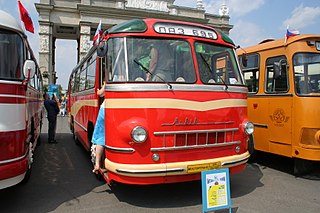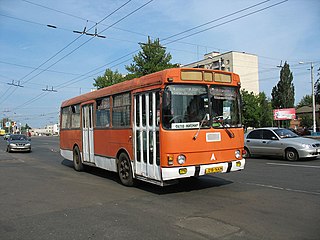
The Lviv Automobile Factory, mostly known under its obsolete name L’vivs’ky Avtobusnyi Zavod was a bus manufacturing company in Lviv, Ukraine. Their brand-name is LAZ (ЛАЗ), and the company and its products are often referred to with this acronym rather than the full name.

The British Rail Class 82 electric locomotives were designed by the British manufacturing interest Metropolitan-Vickers and produced by Beyer, Peacock and Company on behalf of British Rail (BR).

Bogdan Corporation is a leading Ukrainian automobile trading and manufacturing group founded by Bogdan Motors. The corporation was famous for its Bogdan public transport brand that used to produce its models in Cherkasy and Lutsk.

ZiU-9, or ZIU-9 is a Soviet trolleybus. Other names for the ZiU-9 are ZiU-682 and HTI-682. The ZiU acronym stands for Zavod imeni Uritskogo, which is a factory named after Moisei Uritsky, the Russian revolutionary. Before 1996 this acronym was also a trademark of the vehicle manufacturer Trolza. The ZiU-9 was first built in 1966, although it was only put into mass production in 1972 and it was still assembled along with other more advanced trolleybus vehicles in the Trolza factory until 2015. The total number of produced ZiU-9s exceeds 42,000 vehicles making it the most produced trolleybus in the world. In addition, many copies of ZiU-9 were made in other factories of the former Soviet bloc.

The Lviv tram is an electric tram in Lviv, Ukraine. It is the only tram system in the Western Ukraine, and the largest among narrow-gauge tram systems in Ukraine.

The Volvo FL is Volvo's smallest truck and is suitable for local and regional distribution operations, refuse collection, construction truck or small format tractor. The Volvo FL has been built since the summer of 1985 in a variety of different models of different weight ratings. The latest model has been sold since 2013.

A heater core is a radiator-like device used in heating the cabin of a vehicle. Hot coolant from the vehicle's engine is passed through a winding tube of the core, a heat exchanger between coolant and cabin air. Fins attached to the core tubes serve to increase surface area for heat transfer to air that is forced past them by a fan, thereby heating the passenger compartment.

Charles H Roe was a Yorkshire coachbuilding company. It was for most of its life based at Crossgates Carriage Works, in Leeds.
Rocar was a van, light truck, bus and trolleybus manufacturer based in Bucharest, Romania. The firm also produced light offroad vehicles and later heavy road vehicles. During its existence, the company produced over 350,000 vehicles.
Rosenergomash is a Russian electro-mechanical manufacturer and operator, which owns or operates several plants in Ukraine and Russia. Corporate headquarters are in Moscow. The current President of the company is Vladimir Palikhata.

The Automotive industry in Ukraine was established during the Soviet times and until fall of the Soviet Union was an integral part of automotive industry of the Soviet Union. The first Ukraine-based motor vehicle brands were established in the late 1950s.

The LAZ-695 is a Soviet/Ukrainian 2 axle urban/suburban bus, which was produced in the Western Ukrainian city Lviv from 1965 to 2002. After the production stop at the main factory in Lviv, the documentation was handed over to the DAZ automotive facility in the Ukrainian city Kamianske, where the production continued up to 2010. In over 50 years of manufacturing there were built over 250 000 units of various modifications, made the model one of the most widespread buses in the Soviet Union and the LAZ factory the biggest bus manufacturer in Europe in the 1980s. The bus belongs to the model series 69x, which includes also the LAZ-697 “Tourist” and the LAZ-699.

The Belkommunmash BKM-321 is a Belarusian large capacity low-floor trolleybus for intercity passenger transportation, mass-produced since 2003. It belongs to the third generation of trolleybuses developed by the Belkommunmash plant in Minsk.
Lvivelectrotrans is a city monopolist in the field of electric transport of Lviv, a municipal enterprise owned by the Lviv community and is the operator of trams and trolleybuses in the city.

LAZ-697 “Tourist” was a Soviet 2 axle, middle-class coach, which was produced in the Western Ukrainian city Lviv from 1959 to 1985. The model was derived from the LAZ-695, during the developing process of it. Because of that, both bus models are technically identical. LAZ-697 was used for touristic purposes as well as for shorter intercity-trips and so was more comfortable as the LAZ-695. It was taken out of production in 1985, in favor of the upper-class coach LAZ-699.

The LAZ-699 is a LAZ-697 lengthened by one section, an upper-class coach, based on the city and suburban bus, LAZ-695. It was serially built from 1964 to 2002, in the Ukrainian city Lviv. In that time, a lot of prototypes were developed in addition to special luxury modifications and special vehicles for transporting astronauts on the Baikonur Cosmodrome. The serial production of the first modifications was modest. Only in 1985, when the production of the LAZ-697 was cancelled, were the free production capacities used for starting mass production of the LAZ-699.

Electrotrans is a Ukrainian-German enterprise that was established in 2011 by Electron Corporation, TransTec Vetschau GmbH (Germany) and Avtotechnoproekt LLC.

Etalon T121/T122 Barvinok (periwinkle) is a Ukrainian low-entry trolleybus of large capacity, produced at the Chernihiv Bus Factory since 2013. This model was based on the BKM-321 trolleybus using the body of the BAZ A111 bus. There are currently 43 trolleybuses in operation.

The LAZ-4202 is a middle-class urban and suburban bus. It was serially built from 1978 to 1993, in the Ukrainian city of Lviv. The intention was to develop a cheap and the first serial diesel-powered city bus with serial automatic transmission. Due to initial lacks in quality and many teeth troubles, it could not replace its predecessor, LAZ-695, which remained in production for further 15 years, after the discontinuation of the 4202 series.

The Lviv trolleybus is a trolleybus system in Lviv, Ukraine. The trolleybus network is operated by Lvivelectrotrans - a municipal enterprise, that is the operator of trams and trolleybuses in the city. LET is owned by the Lviv city council. The length of the contact network is 136 km (01.2023), and the length of the route network is 169 km (01.2021). As of 2021, 24,678,300 paid passengers used trams and trolleybuses. In 2021, trolleybuses performed 3.29 million kilometers of transportation work (vehicle-km).




















